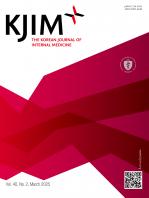|
Endocrinology-metabolism / Original Article
ApoB/ApoA-I ratio is independently associated with carotid atherosclerosis in type 2 diabetes mellitus with well-controlled LDL cholesterol levels
Ji Eun Jun, Young Ju Choi, Yong-Ho Lee, Dae Jung Kim, Seok Won Park, Byung Wook Huh, Eun Jig Lee, Sun-Ha Jee, Kyu Yeon Hur, Sung Hee Choi, Kap Bum Huh
Korean J Intern Med. 2018;33(1):138-147. Published online December 28, 2017
Background/Aims: This study aimed to investigate whether the apolipoprotein (Apo) B/ApoA-I ratio is associated with carotid intima-media thickness (CIMT) in type 2 diabetes mellitus (T2DM) subjects with low density lipoprotein cholesterol (LDL-C) levels less than 100 mg/dL. Methods: This cross-secti..
|
|
|
Endocrinology-metabolism / Review
Combination therapy of oral hypoglycemic agents in patients with type 2 diabetes mellitus
Min Kyong Moon, Kyu Yeon Hur, Seung-Hyun Ko, Seok-O Park, Byung-Wan Lee, Jin Hwa Kim, Sang Youl Rhee, Hyun Jin Kim, Kyung Mook Choi, Nan-Hee Kim; on behalf of the Committee of Clinical Practice Guidelines of the Korean Diabetes Association
Korean J Intern Med. 2017;32(6):974-983. Published online October 27, 2017
The Korean Diabetes Association (KDA) recently updated the Clinical Practice Guidelines on antihyperglycemic agent therapy for adult patients with type 2 diabetes mellitus (T2DM). In combination therapy of oral hypoglycemic agents (OHAs), general recommendations were not changed from those of the 20..
|
|
|
Endocrinology-metabolism / Review
Insulin therapy for adult patients with type 2 diabetes mellitus: a position statement of the Korean Diabetes Association, 2017
Byung-Wan Lee, Jin Hwa Kim, Seung-Hyun Ko, Kyu Yeon Hur, Nan-Hee Kim, Sang Youl Rhee, Hyun Jin Kim, Min Kyong Moon, Seok-O Park, Kyung Mook Choi; on behalf of the Committee of Clinical Practice Guideline of Korean Diabetes Association
Korean J Intern Med. 2017;32(6):967-973. Published online October 23, 2017
The Korean Diabetes Association (KDA) has regularly updated its Clinical Practice Guidelines. In 2017, the KDA published a position statement on the use of antihyperglycemic agents for patients with type 2 diabetes mellitus (T2DM). Growing evidence from new multinational clinical trials using novel ..
|
|
|
Endocrinology-metabolism / Review
Monotherapy in patients with type 2 diabetes mellitus
Sang Youl Rhee, Hyun Jin Kim, Seung-Hyun Ko, Kyu Yeon Hur, Nan-Hee Kim, Min Kyong Moon, Seok-O Park, Byung-Wan Lee, Kyung Mook Choi, Jin Hwa Kim; Committee of Clinical Practice Guideline of Korean Diabetes Association
Korean J Intern Med. 2017;32(6):959-966. Published online October 23, 2017
In order to improve the quality of life and to prevent chronic complications related to diabetes mellitus, intensive lifestyle modification and proper medication are needed from the early stage of diagnosis of type 2 diabetes mellitus (T2DM). When using the first medication for diabetic patients, th..
|
|
|
Endocrinology-metabolism / Review
Antihyperglycemic agent therapy for adult patients with type 2 diabetes mellitus 2017: a position statement of the Korean Diabetes Association
Seung-Hyun Ko, Kyu Yeon Hur, Sang Youl Rhee, Nan-Hee Kim, Min Kyong Moon, Seok-O Park, Byung-Wan Lee, Hyun Jin Kim, Kyung Mook Choi, Jin Hwa Kim; Committee of Clinical Practice Guideline of Korean Diabetes Association
Korean J Intern Med. 2017;32(6):947-958. Published online October 23, 2017
In 2017, the Korean Diabetes Association (KDA) published a position statement on the use of antihyperglycemic agents for patients with type 2 diabetes mellitus (T2DM). The KDA regularly updates its Clinical Practice Guidelines, but since the last update in 2015, many results from clinical trials hav..
|
|
|
Original Article
Diagnostic Value of a Chimeric TSH Receptor (Mc4)-Based Bioassay for Graves' Disease
Ji In Lee, Hye Won Jang, Soo Kyoung Kim, Joon Young Choi, Ji Young Kim, Kyu Yeon Hur, Jae Hyeon Kim, Yong-Ki Min, Jae Hoon Chung, Sun Wook Kim
Korean J Intern Med. 2011;26(2):179-186. Published online June 1, 2011
Background/AimsGraves' disease (GD) is caused by thyroid-stimulating hormone receptor (TSHR) and thyroid-stimulating immunoglobulin (TSI). We used a recently introduced, technically enhanced TSI bioassay to assess its diagnostic value and determine the cut-off in patients in h..
|
|
|
















